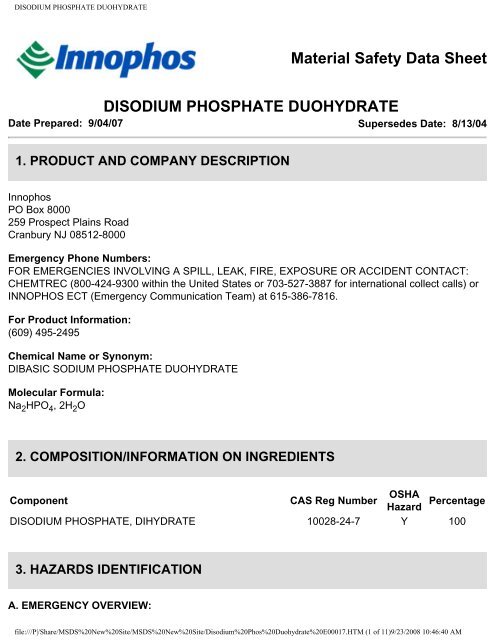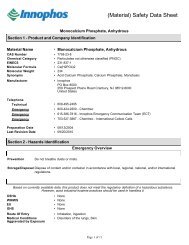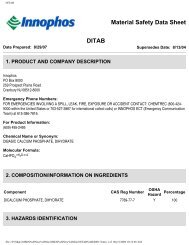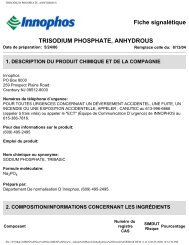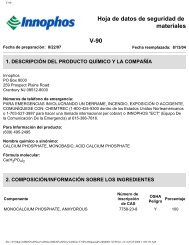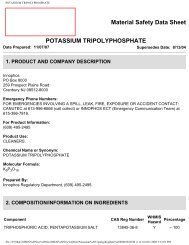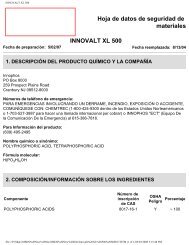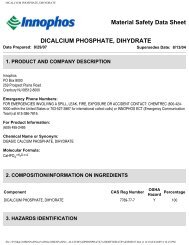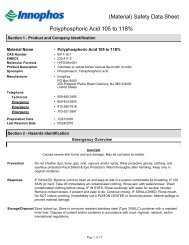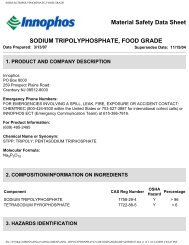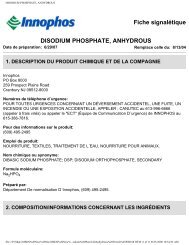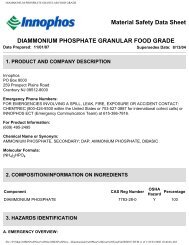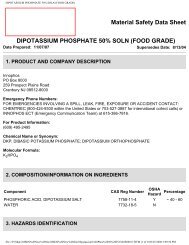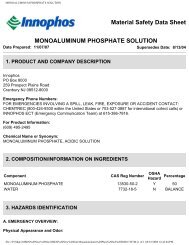DISODIUM PHOSPHATE DUOHYDRATE - Innophos
DISODIUM PHOSPHATE DUOHYDRATE - Innophos
DISODIUM PHOSPHATE DUOHYDRATE - Innophos
You also want an ePaper? Increase the reach of your titles
YUMPU automatically turns print PDFs into web optimized ePapers that Google loves.
<strong>DISODIUM</strong> <strong>PHOSPHATE</strong> <strong>DUOHYDRATE</strong><br />
Material Safety Data Sheet<br />
<strong>DISODIUM</strong> <strong>PHOSPHATE</strong> <strong>DUOHYDRATE</strong><br />
Date Prepared: 9/04/07 Supersedes Date: 8/13/04<br />
1. PRODUCT AND COMPANY DESCRIPTION<br />
<strong>Innophos</strong><br />
PO Box 8000<br />
259 Prospect Plains Road<br />
Cranbury NJ 08512-8000<br />
Emergency Phone Numbers:<br />
FOR EMERGENCIES INVOLVING A SPILL, LEAK, FIRE, EXPOSURE OR ACCIDENT CONTACT:<br />
CHEMTREC (800-424-9300 within the United States or 703-527-3887 for international collect calls) or<br />
INNOPHOS ECT (Emergency Communication Team) at 615-386-7816.<br />
For Product Information:<br />
(609) 495-2495<br />
Chemical Name or Synonym:<br />
DIBASIC SODIUM <strong>PHOSPHATE</strong> <strong>DUOHYDRATE</strong><br />
Molecular Formula:<br />
Na 2 HPO 4 , 2H 2 O<br />
2. COMPOSITION/INFORMATION ON INGREDIENTS<br />
OSHA<br />
Component<br />
CAS Reg Number<br />
Hazard Percentage<br />
<strong>DISODIUM</strong> <strong>PHOSPHATE</strong>, DIHYDRATE 10028-24-7 Y 100<br />
3. HAZARDS IDENTIFICATION<br />
A. EMERGENCY OVERVIEW:<br />
file:///P|/Share/MSDS%20New%20Site/MSDS%20New%20Site/Disodium%20Phos%20Duohydrate%20E00017.HTM (1 of 11)9/23/2008 10:46:40 AM
<strong>DISODIUM</strong> <strong>PHOSPHATE</strong> <strong>DUOHYDRATE</strong><br />
Physical Appearance and Odor:<br />
white powder solid, odorless.<br />
Warning Statements:<br />
CAUTION! MAY CAUSE SKIN AND EYE IRRITATION.<br />
B. POTENTIAL HEALTH EFFECTS:<br />
Acute Eye:<br />
May cause irritation.<br />
Acute Skin:<br />
Skin absorption not likely. May cause irritation.<br />
Acute Inhalation:<br />
May cause upper respiratory tract irritation.<br />
Acute Ingestion:<br />
Ingestion of large quantities may cause irritation, nausea, vomiting, diarrhea, abdominal cramps.<br />
Chronic Effects:<br />
This product does not contain any ingredient designated by IARC, NTP, ACGIH or OSHA as probable<br />
or suspected human carcinogens.<br />
4. FIRST AID MEASURES<br />
FIRST AID MEASURES FOR ACCIDENTAL:<br />
Eye Exposure:<br />
Hold eyelids open and flush with a steady, gentle stream of water for at least 15 minutes. Seek medical<br />
attention if irritation develops or persists or if visual changes occur.<br />
Skin Exposure:<br />
In case of contact, immediately wash with plenty of soap and water for at least 5 minutes. Seek<br />
medical attention if irritation developes or persists. Remove contaminated clothing and shoes. Clean<br />
contaminated clothing and shoes before re-use.<br />
Inhalation:<br />
If respiratory irritation or distress occurs remove victim to fresh air. Seek medical attention if respiratory<br />
irritation or distress continues.<br />
Ingestion:<br />
Do not induce vomiting unless instructed to do so by a physician. No harmful affects expected. If<br />
appreciable quantities are swallowed, call a physician or poison control center. Do not leave victim<br />
file:///P|/Share/MSDS%20New%20Site/MSDS%20New%20Site/Disodium%20Phos%20Duohydrate%20E00017.HTM (2 of 11)9/23/2008 10:46:40 AM
<strong>DISODIUM</strong> <strong>PHOSPHATE</strong> <strong>DUOHYDRATE</strong><br />
unattended.<br />
MEDICAL CONDITIONS POSSIBLY AGGRAVATED BY EXPOSURE:<br />
Inhalation of product may aggravate existing chronic respiratory problems such as asthma,<br />
emphysema or bronchitis. Skin contact may aggravate existing skin disease.<br />
NOTES TO PHYSICIAN:<br />
All treatments should be based on observed signs and symptoms of distress in the patient.<br />
Consideration should be given to the possibility that overexposure to materials other than this product<br />
may have occurred.<br />
Ingestion of large quantities of phosphate salts (over 1.0 grams for an adult) may cause an osmotic<br />
catharsis resulting in diarrhea and probable abdominal cramps. Larger doses such as 4-8 grams will<br />
almost certainly cause these effects in everyone. In healthy individuals most of the ingested salt will be<br />
excreted in the feces with the diarrhea and, thus, not cause any systemic toxicity. Doses greater than<br />
10 grams hypothetically may cause systemic toxicity. Treatment should take into consideration both<br />
anionic and cation portion of the molecule. The following treatments should be considered for the<br />
specific group(s) of phosphate salts found in this product:<br />
--All phosphate salts, except calcium salts, have a hypothetical risk of hypocalcemia, so calcium levels<br />
should be monitored.<br />
--Ammonium salts have a hypothetical risk of ammonia toxicity. In addition to calcium levels, ammonia<br />
and phosphate levels should be monitored.<br />
--Potassium salts have a hypothetical risk of hyperkalemia which can cause cardiac arrhythmia. In<br />
addition to calcium levels, potassium and phosphate levels should be monitored. Also consider<br />
continuous EKG monitoring to detect hyperkalemia.<br />
--Sodium salts have a hypothetical risk of hypernatremia. In addition to calcium levels, sodium and<br />
phosphate levels should be monitored.<br />
5. FIRE FIGHTING MEASURES<br />
FIRE HAZARD DATA:<br />
Flash Point:<br />
Not Applicable<br />
Extinguishing Media:<br />
Not combustible. Use extinguishing method suitable for surrounding fire.<br />
Special Fire Fighting Procedures:<br />
Firefighters should wear NIOSH/MSHA approved self-contained breathing apparatus and full protective<br />
clothing. Dike area to prevent runoff and contamination of water sources. Dispose of fire control water<br />
file:///P|/Share/MSDS%20New%20Site/MSDS%20New%20Site/Disodium%20Phos%20Duohydrate%20E00017.HTM (3 of 11)9/23/2008 10:46:40 AM
<strong>DISODIUM</strong> <strong>PHOSPHATE</strong> <strong>DUOHYDRATE</strong><br />
later.<br />
Unusual Fire and Explosion Hazards:<br />
Not combustible.<br />
Hazardous Decomposition Materials (Under Fire Conditions):<br />
oxides of sodium<br />
oxides of phosphorus<br />
6. ACCIDENTAL RELEASE MEASURES<br />
Evacuation Procedures and Safety:<br />
Wear appropriate protective gear for the situation. See Personal Protection information in Section 8.<br />
Containment of Spill:<br />
Dike or retain dilution water or water from firefighting for later disposal. Follow procedure described<br />
below under Cleanup and Disposal of Spill.<br />
Cleanup and Disposal of Spill:<br />
Sweep or vacuum up and place in an appropriate closed container (see Section 7: Handling and<br />
Storage). Avoid creation of dusty conditions. Clean up residual material by washing area with water<br />
and detergent.<br />
Environmental and Regulatory Reporting:<br />
Runoff from fire control or dilution water may cause pollution. Spills may be reportable to the National<br />
Response Center (800-424-8802) and to state and/or local agencies.<br />
7. HANDLING AND STORAGE<br />
Minimum/Maximum Storage Temperatures:<br />
Not Available<br />
Handling:<br />
Avoid direct or prolonged contact with skin and eyes. Keep containers closed when not being used.<br />
Avoid breathing dusts.<br />
Storage:<br />
Store in closed containers. Store in an area that is cool, dry, This product is hygroscopic and tends to<br />
cake on storage.<br />
file:///P|/Share/MSDS%20New%20Site/MSDS%20New%20Site/Disodium%20Phos%20Duohydrate%20E00017.HTM (4 of 11)9/23/2008 10:46:40 AM
<strong>DISODIUM</strong> <strong>PHOSPHATE</strong> <strong>DUOHYDRATE</strong><br />
8. EXPOSURE CONTROLS/PERSONAL PROTECTION<br />
Introductory Remarks:<br />
These recommendations provide general guidance for handling this product. Because specific work<br />
environments and material handling practices vary, safety procedures should be developed for each<br />
intended application. While developing safe handling procedures, do not overlook the need to clean<br />
equipment and piping systems for maintenance and repairs. Waste resulting from these procedures<br />
should be handled in accordance with Section 13: Disposal Considerations.<br />
Assistance with selection, use and maintenance of worker protection equipment is generally available<br />
from equipment manufacturers.<br />
Exposure Guidelines:<br />
Exposure limits represent regulated or recommended worker breathing zone concentrations measured<br />
by validated sampling and analytical methods, meeting the regulatory requirements. The following<br />
limits apply to this material, where, if indicated, S=skin and C=ceiling limit:<br />
PARTICULATES NOT OTHERWISE REGULATED RESPIRABLE FRACTION<br />
Notes TWA STEL<br />
OSHA<br />
5 mg/cu m<br />
PARTICULATES NOT OTHERWISE REGULATED TOTAL DUST<br />
Notes TWA STEL<br />
OSHA<br />
15 mg/cu m<br />
Engineering Controls:<br />
Where engineering controls are indicated by use conditions or a potential for excessive exposure<br />
exists, the following traditional exposure control techniques may be used to effectively minimize<br />
employee exposures: local exhaust ventilation at the point of generation, general area dilution/exhaust<br />
ventilation.<br />
Respiratory Protection:<br />
When respirators are required, select NIOSH/MSHA approved equipment based on actual or potential<br />
airborne concentrations and in accordance with the appropriate regulatory standards and/or industrial<br />
recommendations.<br />
Under normal conditions, in the absence of other airborne contaminants, the following devices should<br />
provide protection from this material up to the conditions specified by the appropriate OSHA, WHMIS<br />
or ANSI standard(s): dust/mist filtering respirator.<br />
Eye/Face Protection:<br />
Eye and face protection requirements will vary dependent upon work environment conditions and<br />
material handling practices. Appropriate ANSI Z87 approved equipment should be selected for the<br />
particular use intended for this material.<br />
file:///P|/Share/MSDS%20New%20Site/MSDS%20New%20Site/Disodium%20Phos%20Duohydrate%20E00017.HTM (5 of 11)9/23/2008 10:46:40 AM
<strong>DISODIUM</strong> <strong>PHOSPHATE</strong> <strong>DUOHYDRATE</strong><br />
It is generally regarded as good practice to wear a minimum of safety glasses with side shields when<br />
working in industrial environments.<br />
Skin Protection:<br />
Skin contact should be minimized through use of gloves and suitable long-sleeved clothing (i.e., shirts<br />
and pants). Consideration must be given both to durability as well as permeation resistance.<br />
Work Practice Controls:<br />
Personal hygiene is an important work practice exposure control measure and the following general<br />
measures should be taken when working with or handling this material:<br />
(1) Do not use, and/or consume foods, beverages, tobacco products, or cosmetics in areas<br />
where this material is stored.<br />
(2) Wash hands and face carefully before eating, drinking, using tobacco, applying cosmetics,<br />
or using the toilet.<br />
(3) Wash exposed skin promptly to remove accidental splashes or contact with this material.<br />
9. PHYSICAL AND CHEMICAL PROPERTIES<br />
Physical and Chemical properties here represent typical properties of this product. Contact the<br />
business area using the Product Information phone number in Section 1 for its exact specifications.<br />
Physical Appearance:<br />
white powder solid.<br />
Odor:<br />
odorless.<br />
pH:<br />
9.1 at 1 wt/wt%.<br />
Specific Gravity:<br />
Not Available<br />
Water Solubility:<br />
soluble<br />
Melting Point Range:<br />
Not Available<br />
Boiling Point Range:<br />
Not Available<br />
Vapor Pressure:<br />
Not Available<br />
file:///P|/Share/MSDS%20New%20Site/MSDS%20New%20Site/Disodium%20Phos%20Duohydrate%20E00017.HTM (6 of 11)9/23/2008 10:46:40 AM
<strong>DISODIUM</strong> <strong>PHOSPHATE</strong> <strong>DUOHYDRATE</strong><br />
Vapor Density:<br />
Not Available<br />
Molecular Weight:<br />
178.05<br />
10. STABILITY AND REACTIVITY<br />
Chemical Stability:<br />
This material is stable under normal handling and storage conditions described in Section 7.<br />
Conditions To Be Avoided:<br />
extreme heat<br />
moisture<br />
Materials/Chemicals To Be Avoided:<br />
strong acids<br />
alkaloids<br />
pyrogallol<br />
lead acetate<br />
resorcinol<br />
antipyrine<br />
chloral hydrate<br />
Decomposition Temperature Range:<br />
120 C (248 F)<br />
The Following Hazardous Decomposition Products Might Be Expected:<br />
Decomposition Type: thermal<br />
oxides of sodium<br />
oxides of phosphorus<br />
Hazardous Polymerization Will Not Occur.<br />
Avoid The Following To Inhibit Hazardous Polymerization:<br />
not applicable<br />
11. TOXICOLOGICAL INFORMATION<br />
Acute Eye Irritation:<br />
The following data are for similar or related products.<br />
file:///P|/Share/MSDS%20New%20Site/MSDS%20New%20Site/Disodium%20Phos%20Duohydrate%20E00017.HTM (7 of 11)9/23/2008 10:46:40 AM
<strong>DISODIUM</strong> <strong>PHOSPHATE</strong> <strong>DUOHYDRATE</strong><br />
Toxicological Information and Interpretation:<br />
eye - eye irritation, rabbit. Mildly irritating. Data for anhydrous form of disodium phosphate.<br />
Acute Skin Irritation:<br />
The following data is for similar or related products.<br />
Toxicological Information and Interpretation:<br />
skin - skin irritation, rabbit. Moderately irritating. Data for anhydrous form of disodium phosphate.<br />
Acute Dermal Toxicity:<br />
No test data found for product.<br />
Acute Respiratory Irritation:<br />
No test data found for product.<br />
Acute Inhalation Toxicity:<br />
No test data found for product.<br />
Acute Oral Toxicity:<br />
The following data is for similar or related products.<br />
Toxicological Information and Interpretation:<br />
LD50 - lethal dose 50% of test species, > 17000 mg/kg, rat. Data for anhydrous form of disodium<br />
phosphate.<br />
Chronic Toxicity:<br />
This product does not contain any substances that are considered by OSHA, NTP, IARC or ACGIH to<br />
be "probable" or "suspected" human carcinogens.<br />
12. ECOLOGICAL INFORMATION<br />
Ecotoxicological Information:<br />
No data found for product.<br />
Chemical Fate Information:<br />
No data found for product.<br />
13. DISPOSAL CONSIDERATIONS<br />
Waste Disposal Method:<br />
Chemical additions, processing or otherwise altering this material may make the waste management<br />
information presented in this MSDS incomplete, inaccurate or otherwise inappropriate. Please be<br />
advised that state and local requirements for waste disposal may be more restrictive or otherwise<br />
file:///P|/Share/MSDS%20New%20Site/MSDS%20New%20Site/Disodium%20Phos%20Duohydrate%20E00017.HTM (8 of 11)9/23/2008 10:46:40 AM
<strong>DISODIUM</strong> <strong>PHOSPHATE</strong> <strong>DUOHYDRATE</strong><br />
different from federal laws and regulations. Consult state and local regulations regarding the proper<br />
disposal of this material.<br />
EPA Hazardous Waste - NO<br />
14. TRANSPORTATION INFORMATION<br />
Transportation Status: IMPORTANT! Statements below provide additional data on listed DOT<br />
classification.<br />
This product is regulated for transportation because it contains a reportable quantity of a hazardous<br />
substance found in Appendix A to 49 CFR 172.101. Depending on the amount of the hazardous<br />
substance present, certain package sizes may be exempt from the transport regulations and can be<br />
shipped as non-regulated materials. Please check the ingredient listing found in Section 2 of this<br />
MSDS to determine if the quantity of hazardous substance present in this product would be regulated<br />
in the package size being shipped. The listed Transportation Classification does not address regulatory<br />
variations due to changes in package size, mode of shipment or other regulatory descriptors.<br />
US Department of Transportation<br />
Hazard Class..... 9<br />
Shipping Name:<br />
ENVIRONMENTALLY HAZARDOUS SUBSTANCE, SOLID, N.O.S.<br />
Technical Shipping Name:<br />
SODIUM <strong>PHOSPHATE</strong>, DIBASIC<br />
ID Number....... UN3077<br />
Packing Group.... III<br />
Labels........... CLASS 9<br />
Emergency Guide #.... 171<br />
15. REGULATORY INFORMATION<br />
Inventory Status<br />
Inventory Status<br />
UNITED STATES (TSCA)<br />
Y<br />
CANADA (DSL)<br />
Y<br />
EUROPE (EINECS/ELINCS)<br />
Y<br />
AUSTRALIA (AICS)<br />
Y<br />
JAPAN (MITI)<br />
Y<br />
SOUTH KOREA (KECL)<br />
Y<br />
Y = All ingredients are on the inventory.<br />
file:///P|/Share/MSDS%20New%20Site/MSDS%20New%20Site/Disodium%20Phos%20Duohydrate%20E00017.HTM (9 of 11)9/23/2008 10:46:40 AM
<strong>DISODIUM</strong> <strong>PHOSPHATE</strong> <strong>DUOHYDRATE</strong><br />
E = All ingredients are on the inventory or exempt from listing.<br />
P = One or more ingredients fall under the polymer exemption or are on the no longer polymer list. All<br />
other ingredients are on the inventory or exempt from listing.<br />
N = Not determined or one or more ingredients are not on the inventory and are not exempt from<br />
listing.<br />
FEDERAL REGULATIONS<br />
Inventory Issues:<br />
The hydrated components of this product are listed on the TSCA Inventory under their parent<br />
anhydrous compounds.<br />
SARA Title III Hazard Classes:<br />
Fire Hazard<br />
Reactive Hazard<br />
Release of Pressure<br />
Acute Health Hazard<br />
Chronic Health Hazard<br />
- NO<br />
- NO<br />
- NO<br />
- YES<br />
- NO<br />
OTHER FEDERAL REGULATIONS:<br />
FDA Status:<br />
This product meets the compositional requirements of:<br />
21 CFR 182.1778 SODIUM <strong>PHOSPHATE</strong><br />
STATE REGULATIONS:<br />
This product does not contain any components that are regulated under California Proposition 65.<br />
16. OTHER INFORMATION<br />
National Fire Protection Association Hazard Ratings--NFPA(R):<br />
1 Health Hazard Rating--Slight<br />
0 Flammability Rating--Minimal<br />
0 Instability Rating--Minimal<br />
National Paint & Coating Hazardous Materials Identification System--HMIS(R):<br />
1 Health Hazard Rating--Slight<br />
0 Flammability Rating--Minimal<br />
0 Reactivity Rating--Minimal<br />
Reason for Revisions:<br />
Change and/or addition made to Section 4, Section 8.<br />
file:///P|/Share/MSDS%20New%20Site/MSDS%20New%20Site/Disodium%20Phos%20Duohydrate%20E00017.HTM (10 of 11)9/23/2008 10:46:40 AM
<strong>DISODIUM</strong> <strong>PHOSPHATE</strong> <strong>DUOHYDRATE</strong><br />
Key Legend Information:<br />
ACGIH - American Conference of Governmental Industrial Hygienists<br />
OSHA - Occupational Safety and Health Administration<br />
TLV - Threshold Limit Value<br />
PEL - Permissable Exposure Limit<br />
TWA - Time Weighted Average<br />
STEL - Short Term Exposure Limit<br />
NTP - National Toxicology Program<br />
IARC - International Agency for Research on Cancer<br />
ND - Not determined<br />
RPI - INNOPHOS Established Exposure Limits<br />
Disclaimer:<br />
The information herein is given in good faith but no warranty, expressed or implied, is made.<br />
** End of MSDS Document **<br />
file:///P|/Share/MSDS%20New%20Site/MSDS%20New%20Site/Disodium%20Phos%20Duohydrate%20E00017.HTM (11 of 11)9/23/2008 10:46:40 AM


